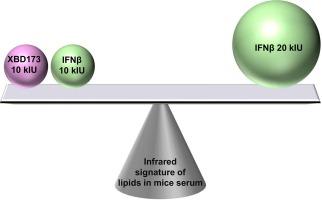Assessment of the concomitant action of XBD173 and interferon β in a mouse model of multiple sclerosis using infrared marker bands
IF 4.3
2区 化学
Q1 SPECTROSCOPY
Spectrochimica Acta Part A: Molecular and Biomolecular Spectroscopy
Pub Date : 2024-11-03
DOI:10.1016/j.saa.2024.125390
引用次数: 0
Abstract
Disease modifying therapies including interferon-β (IFNβ) effectively counteract the inflammatory component in relapsing-remitting multiple sclerosis (RRMS) but this action, generally associated with severe side effects, does not prevent axonal/neuronal damages. Hence, axonal neuroprotection, which is pivotal for MS effective treatment, remains a difficult clinical challenge. Growing evidence suggested as promising candidate for neuroprotection, Emapunil (AC-5216) or XBD173, a ligand of the mitochondrial translocator protein highly expressed in glial cells and neurons. Indeed, elegant studies previously showed that low and well tolerated doses of XBD173 efficiently improved clinical symptoms and neuropathological markers in MS mice. Here we combined clinical scoring in vivo with Fourier transform infrared spectroscopy of sera samples to investigate the hypothesis that the concomitant treatment of RRMS mice with low doses of IFNβ and XBD173 may increase their beneficial effects against MS symptoms and additionally decrease IFNβ-induced side effects. Our results show a significant alteration of the composition of serum protein and lipids in the spectra of the sera of RRMS mice. While the signature of proteins remains altered upon treatment, the signature of lipids is recovered comparatively well with 20 kIU IFNβ and upon concomitant treatment with a low dose of XBD173 (10 mg/kg) and IFNβ (10 kIU), but not with 10 kIU of IFNβ alone. The concomitant therapy with XBD173 (10 mg/kg) and IFNβ (10 kIU), devoid of side effects, exhibited at least equal or even better efficacy than IFNβ (20 kIU) treatment against RRMS symptoms.

利用红外标记带评估 XBD173 和干扰素 β 在多发性硬化症小鼠模型中的协同作用。
包括干扰素-β(IFNβ)在内的疾病调节疗法能有效对抗复发性多发性硬化症(RRMS)中的炎症成分,但这种疗法通常会带来严重的副作用,而且不能防止轴突/神经元损伤。因此,轴突神经保护是多发性硬化症有效治疗的关键,但仍是一项艰巨的临床挑战。越来越多的证据表明,Emapunil(AC-5216)或XBD173是一种有希望的神经保护候选药物,它是线粒体转运蛋白的配体,在神经胶质细胞和神经元中高度表达。事实上,之前的研究表明,低剂量且耐受性良好的 XBD173 能有效改善多发性硬化症小鼠的临床症状和神经病理学指标。在此,我们将体内临床评分与血清样本的傅立叶变换红外光谱分析相结合,研究同时使用低剂量的 IFNβ 和 XBD173 治疗 RRMS 小鼠可能会增加它们对 MS 症状的有益作用并减少 IFNβ 引起的副作用这一假设。我们的研究结果表明,在 RRMS 小鼠血清的光谱中,血清蛋白和脂质的组成发生了重大变化。虽然蛋白质的特征在治疗后仍会发生改变,但在使用 20 kIU IFNβ,以及同时使用低剂量的 XBD173(10 mg/kg)和 IFNβ(10 kIU)治疗后,脂质的特征恢复得相对较好,而单独使用 10 kIU IFNβ则无法恢复。XBD173(10 mg/kg)和IFNβ(10 kIU)的联合治疗没有副作用,对RRMS症状的疗效至少与IFNβ(20 kIU)相同,甚至更好。
本文章由计算机程序翻译,如有差异,请以英文原文为准。
求助全文
约1分钟内获得全文
求助全文
来源期刊
CiteScore
8.40
自引率
11.40%
发文量
1364
审稿时长
40 days
期刊介绍:
Spectrochimica Acta, Part A: Molecular and Biomolecular Spectroscopy (SAA) is an interdisciplinary journal which spans from basic to applied aspects of optical spectroscopy in chemistry, medicine, biology, and materials science.
The journal publishes original scientific papers that feature high-quality spectroscopic data and analysis. From the broad range of optical spectroscopies, the emphasis is on electronic, vibrational or rotational spectra of molecules, rather than on spectroscopy based on magnetic moments.
Criteria for publication in SAA are novelty, uniqueness, and outstanding quality. Routine applications of spectroscopic techniques and computational methods are not appropriate.
Topics of particular interest of Spectrochimica Acta Part A include, but are not limited to:
Spectroscopy and dynamics of bioanalytical, biomedical, environmental, and atmospheric sciences,
Novel experimental techniques or instrumentation for molecular spectroscopy,
Novel theoretical and computational methods,
Novel applications in photochemistry and photobiology,
Novel interpretational approaches as well as advances in data analysis based on electronic or vibrational spectroscopy.

 求助内容:
求助内容: 应助结果提醒方式:
应助结果提醒方式:


